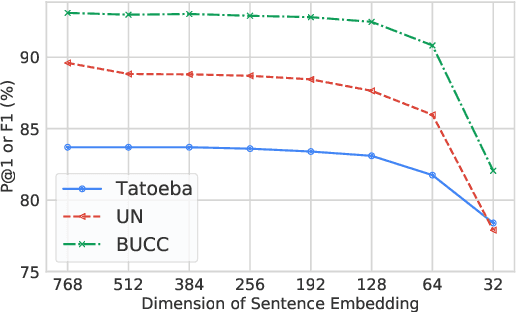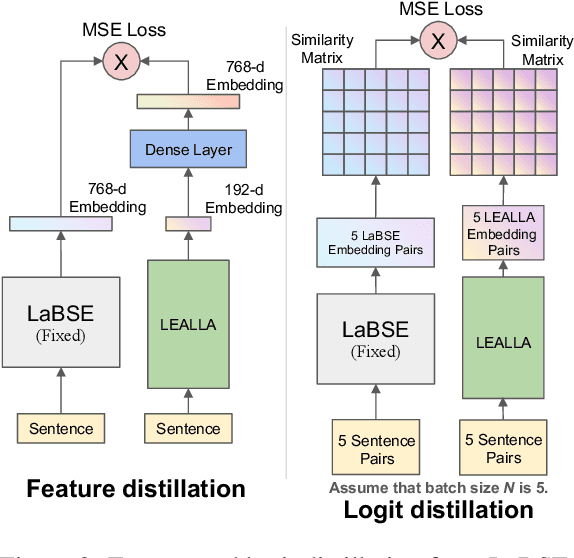Zhuoyuan Mao
Cross-Modal Learning for Music-to-Music-Video Description Generation
Mar 14, 2025Abstract:Music-to-music-video generation is a challenging task due to the intrinsic differences between the music and video modalities. The advent of powerful text-to-video diffusion models has opened a promising pathway for music-video (MV) generation by first addressing the music-to-MV description task and subsequently leveraging these models for video generation. In this study, we focus on the MV description generation task and propose a comprehensive pipeline encompassing training data construction and multimodal model fine-tuning. We fine-tune existing pre-trained multimodal models on our newly constructed music-to-MV description dataset based on the Music4All dataset, which integrates both musical and visual information. Our experimental results demonstrate that music representations can be effectively mapped to textual domains, enabling the generation of meaningful MV description directly from music inputs. We also identify key components in the dataset construction pipeline that critically impact the quality of MV description and highlight specific musical attributes that warrant greater focus for improved MV description generation.
DeepResonance: Enhancing Multimodal Music Understanding via Music-centric Multi-way Instruction Tuning
Feb 18, 2025Abstract:Recent advancements in music large language models (LLMs) have significantly improved music understanding tasks, which involve the model's ability to analyze and interpret various musical elements. These improvements primarily focused on integrating both music and text inputs. However, the potential of incorporating additional modalities such as images, videos and textual music features to enhance music understanding remains unexplored. To bridge this gap, we propose DeepResonance, a multimodal music understanding LLM fine-tuned via multi-way instruction tuning with multi-way aligned music, text, image, and video data. To this end, we construct Music4way-MI2T, Music4way-MV2T, and Music4way-Any2T, three 4-way training and evaluation datasets designed to enable DeepResonance to integrate both visual and textual music feature content. We also introduce multi-sampled ImageBind embeddings and a pre-alignment Transformer to enhance modality fusion prior to input into text LLMs, tailoring DeepResonance for multi-way instruction tuning. Our model achieves state-of-the-art performances across six music understanding tasks, highlighting the benefits of the auxiliary modalities and the structural superiority of DeepResonance. We plan to open-source the models and the newly constructed datasets.
OpenMU: Your Swiss Army Knife for Music Understanding
Oct 21, 2024



Abstract:We present OpenMU-Bench, a large-scale benchmark suite for addressing the data scarcity issue in training multimodal language models to understand music. To construct OpenMU-Bench, we leveraged existing datasets and bootstrapped new annotations. OpenMU-Bench also broadens the scope of music understanding by including lyrics understanding and music tool usage. Using OpenMU-Bench, we trained our music understanding model, OpenMU, with extensive ablations, demonstrating that OpenMU outperforms baseline models such as MU-Llama. Both OpenMU and OpenMU-Bench are open-sourced to facilitate future research in music understanding and to enhance creative music production efficiency.
GLOV: Guided Large Language Models as Implicit Optimizers for Vision Language Models
Oct 08, 2024



Abstract:In this work, we propose a novel method (GLOV) enabling Large Language Models (LLMs) to act as implicit Optimizers for Vision-Langugage Models (VLMs) to enhance downstream vision tasks. Our GLOV meta-prompts an LLM with the downstream task description, querying it for suitable VLM prompts (e.g., for zero-shot classification with CLIP). These prompts are ranked according to a purity measure obtained through a fitness function. In each respective optimization step, the ranked prompts are fed as in-context examples (with their accuracies) to equip the LLM with the knowledge of the type of text prompts preferred by the downstream VLM. Furthermore, we also explicitly steer the LLM generation process in each optimization step by specifically adding an offset difference vector of the embeddings from the positive and negative solutions found by the LLM, in previous optimization steps, to the intermediate layer of the network for the next generation step. This offset vector steers the LLM generation toward the type of language preferred by the downstream VLM, resulting in enhanced performance on the downstream vision tasks. We comprehensively evaluate our GLOV on 16 diverse datasets using two families of VLMs, i.e., dual-encoder (e.g., CLIP) and encoder-decoder (e.g., LLaVa) models -- showing that the discovered solutions can enhance the recognition performance by up to 15.0% and 57.5% (3.8% and 21.6% on average) for these models.
Tuning LLMs with Contrastive Alignment Instructions for Machine Translation in Unseen, Low-resource Languages
Jan 11, 2024Abstract:This article introduces contrastive alignment instructions (AlignInstruct) to address two challenges in machine translation (MT) on large language models (LLMs). One is the expansion of supported languages to previously unseen ones. The second relates to the lack of data in low-resource languages. Model fine-tuning through MT instructions (MTInstruct) is a straightforward approach to the first challenge. However, MTInstruct is limited by weak cross-lingual signals inherent in the second challenge. AlignInstruct emphasizes cross-lingual supervision via a cross-lingual discriminator built using statistical word alignments. Our results based on fine-tuning the BLOOMZ models (1b1, 3b, and 7b1) in up to 24 unseen languages showed that: (1) LLMs can effectively translate unseen languages using MTInstruct; (2) AlignInstruct led to consistent improvements in translation quality across 48 translation directions involving English; (3) Discriminator-based instructions outperformed their generative counterparts as cross-lingual instructions; (4) AlignInstruct improved performance in 30 zero-shot directions.
Variable-length Neural Interlingua Representations for Zero-shot Neural Machine Translation
May 17, 2023Abstract:The language-independency of encoded representations within multilingual neural machine translation (MNMT) models is crucial for their generalization ability on zero-shot translation. Neural interlingua representations have been shown as an effective method for achieving this. However, fixed-length neural interlingua representations introduced in previous work can limit its flexibility and representation ability. In this study, we introduce a novel method to enhance neural interlingua representations by making their length variable, thereby overcoming the constraint of fixed-length neural interlingua representations. Our empirical results on zero-shot translation on OPUS, IWSLT, and Europarl datasets demonstrate stable model convergence and superior zero-shot translation results compared to fixed-length neural interlingua representations. However, our analysis reveals the suboptimal efficacy of our approach in translating from certain source languages, wherein we pinpoint the defective model component in our proposed method.
Exploring the Impact of Layer Normalization for Zero-shot Neural Machine Translation
May 16, 2023Abstract:This paper studies the impact of layer normalization (LayerNorm) on zero-shot translation (ZST). Recent efforts for ZST often utilize the Transformer architecture as the backbone, with LayerNorm at the input of layers (PreNorm) set as the default. However, Xu et al. (2019) has revealed that PreNorm carries the risk of overfitting the training data. Based on this, we hypothesize that PreNorm may overfit supervised directions and thus have low generalizability for ZST. Through experiments on OPUS, IWSLT, and Europarl datasets for 54 ZST directions, we demonstrate that the original Transformer setting of LayerNorm after residual connections (PostNorm) consistently outperforms PreNorm by up to 12.3 BLEU points. We then study the performance disparities by analyzing the differences in off-target rates and structural variations between PreNorm and PostNorm. This study highlights the need for careful consideration of the LayerNorm setting for ZST.
GPT-RE: In-context Learning for Relation Extraction using Large Language Models
May 03, 2023



Abstract:In spite of the potential for ground-breaking achievements offered by large language models (LLMs) (e.g., GPT-3), they still lag significantly behind fully-supervised baselines (e.g., fine-tuned BERT) in relation extraction (RE). This is due to the two major shortcomings of LLMs in RE: (1) low relevance regarding entity and relation in retrieved demonstrations for in-context learning; and (2) the strong inclination to wrongly classify NULL examples into other pre-defined labels. In this paper, we propose GPT-RE to bridge the gap between LLMs and fully-supervised baselines. GPT-RE successfully addresses the aforementioned issues by (1) incorporating task-specific entity representations in demonstration retrieval; and (2) enriching the demonstrations with gold label-induced reasoning logic. We evaluate GPT-RE on four widely-used RE datasets, and observe that GPT-RE achieves improvements over not only existing GPT-3 baselines, but also fully-supervised baselines. Specifically, GPT-RE achieves SOTA performances on the Semeval and SciERC datasets, and competitive performances on the TACRED and ACE05 datasets.
LEALLA: Learning Lightweight Language-agnostic Sentence Embeddings with Knowledge Distillation
Feb 16, 2023



Abstract:Large-scale language-agnostic sentence embedding models such as LaBSE (Feng et al., 2022) obtain state-of-the-art performance for parallel sentence alignment. However, these large-scale models can suffer from inference speed and computation overhead. This study systematically explores learning language-agnostic sentence embeddings with lightweight models. We demonstrate that a thin-deep encoder can construct robust low-dimensional sentence embeddings for 109 languages. With our proposed distillation methods, we achieve further improvements by incorporating knowledge from a teacher model. Empirical results on Tatoeba, United Nations, and BUCC show the effectiveness of our lightweight models. We release our lightweight language-agnostic sentence embedding models LEALLA on TensorFlow Hub.
Textual Enhanced Contrastive Learning for Solving Math Word Problems
Nov 29, 2022



Abstract:Solving math word problems is the task that analyses the relation of quantities and requires an accurate understanding of contextual natural language information. Recent studies show that current models rely on shallow heuristics to predict solutions and could be easily misled by small textual perturbations. To address this problem, we propose a Textual Enhanced Contrastive Learning framework, which enforces the models to distinguish semantically similar examples while holding different mathematical logic. We adopt a self-supervised manner strategy to enrich examples with subtle textual variance by textual reordering or problem re-construction. We then retrieve the hardest to differentiate samples from both equation and textual perspectives and guide the model to learn their representations. Experimental results show that our method achieves state-of-the-art on both widely used benchmark datasets and also exquisitely designed challenge datasets in English and Chinese. \footnote{Our code and data is available at \url{https://github.com/yiyunya/Textual_CL_MWP}
 Add to Chrome
Add to Chrome Add to Firefox
Add to Firefox Add to Edge
Add to Edge